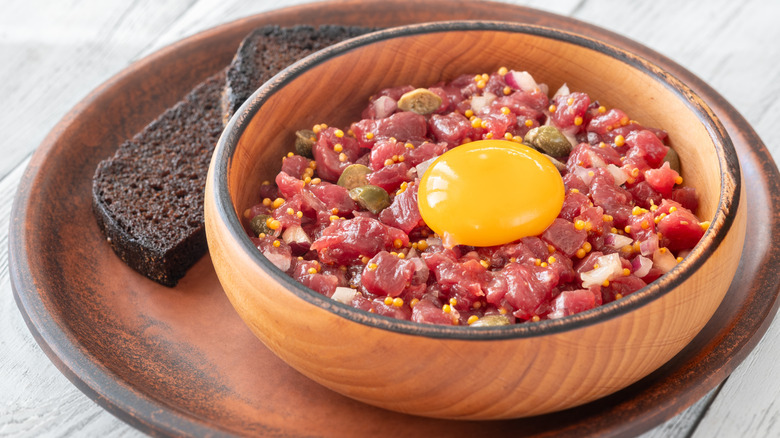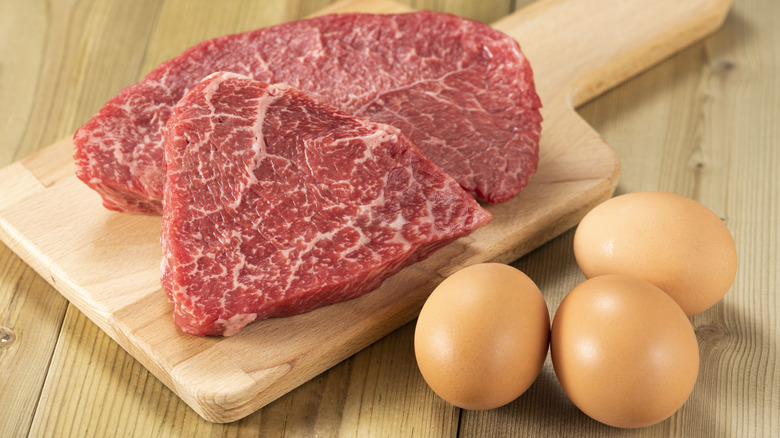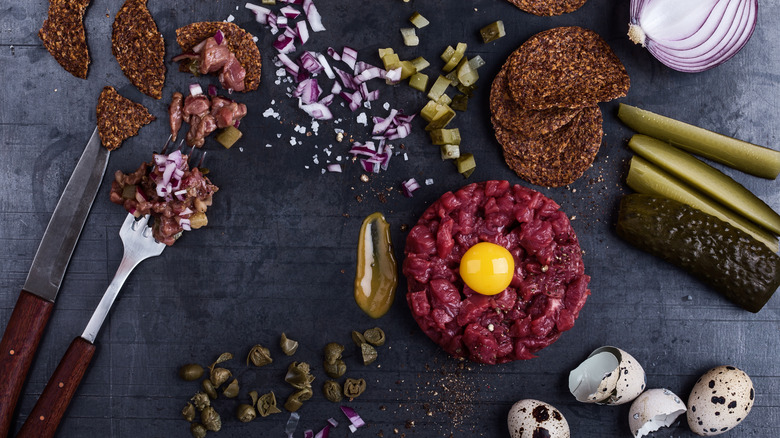Is It Ever Safe To Make Steak Tartare At Home?
Beef can be (relatively) safely consumed at a variety of temperatures that are not considered cooked all the way through — unlike chicken, which must always be fully cooked to 165 degrees Fahrenheit – though Giada de Laurentiis has a trick to check doneness if you don't have a thermometer. You might dabble in medium rare burgers or still-pink-in-the-middle steaks, but the raw beef final boss is definitely steak or beef tartare. If you won't be visiting any fine dining establishments in the near future, but you've always wanted to try it, you might be wondering if you can safely make steak tartare at home. As a matter of fact, you can, according to executive chef Dominick Pepe, from Rocco's Steakhouse, with whom Food Republic had the opportunity to speak. "Using high-quality ingredients and practicing meticulous hygiene are essential safeguards," he said.
That means sourcing the highest-quality, fresh beef (preferably from a trusted butcher or even directly from a farm) and maintaining "clean hands and clean surfaces throughout the preparation process to avoid bacterial growth," Pepe continued. He mentioned that it's also crucial you don't prepare the raw beef and then store it for later. It is safest to eat it right away, as soon as it's ready.
The best types of beef and eggs for steak tartare
In addition to your beef tartare being safe to eat, you also want it to taste great (and feel good in your mouth, too), and some cuts of beef just aren't going to cut it when it comes to tartare. "The best cuts of beef for tartare are tenderloin or filet mignon because you want a cut that is lean and tender," chef Dominick Pepe told us, "because cuts with excessive connective tissue or fat" do not make for a pleasant chew.
He went on to recommend at least Prime grade and told home cooks to avoid Choice and below, as well as any cheap beef, like discount steak from the bargain bin that's close to expiring (its lack of freshness could definitely be harboring bacteria that would otherwise get cooked off, but not where steak tartare is concerned). Perhaps surprisingly, Pepe also warned against using ribeye or strip steak, "due to their higher fat content and potentially tougher texture when raw."
Steak tartare also commonly includes a raw egg yolk on top, too. Pepe strongly suggested using organic eggs because of the "difference in their quality and the reduced risk of contamination." If you can get farm-fresh eggs, directly from the source, all the better, particularly where taste is concerned; there is nothing so delicious as the creamy, rich yolk of a recently laid egg.
Additional ingredients to make your at-home steak tartare sing
Once you have your butcher- or farm-sourced beef chopped and ready to go, you can actually make the steak tartare mixture, starting with a homemade mayonnaise (or just use olive oil). Some people also like a bit of mustard in their tartare, for the zesty bite it brings to the table, which helps balance out the richness of the beef and the mayo. Executive chef Dominick Pepe favors Dijon mustard.
He had some pointers for fun mix-ins to finish off the beef tartare, as well. He said he starts with salt and pepper, but then leans "towards classic old-school French flavors, incorporating cornichons [and] capers;" sometimes, he also adds in a few shakes of Tabasco hot sauce to add a kiss of heat. Some prefer adding a bit of bite from a finely diced onion or shallot as well.
When it comes to seasonings, less is more. "My tip is to taste as you go and adjust to your preference," said Pepe. Just don't overdo it by sprinkling on too much all at once, because you want to allow "the quality of the beef to remain the star" (hence why it's so important to source good meat in the first place). Top the mixture with a velvety, farm-fresh egg yolk, and remember — per Pepe's instructions, serve and eat immediately for safety purposes.



